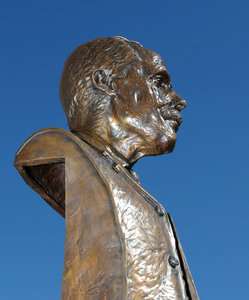

This portrait bust of philanthropist George L. Carter was recently unveiled at ETSU.
JOHNSON CITY, TN – A bronze sculpture of the philanthropist who donated the land upon which East Tennessee State University now sits was unveiled following the closing celebration of the ETSU Centennial.
This portrait bust of George L. Carter (1857-1936), created by Virginia artist Richard G. Pumphrey, is situated outside the main entrance of Carter Hall, ETSU's oldest residence hall and one of the original buildings constructed on the campus in 1911.
The sculpture project was among the first conceived by the university's Centennial Steering Committee. The plaque underneath the sculpture reads: "George L. Carter was once Appalachia's most influential entrepreneur. He built railroads, developed coal mines, and created cities. He donated his farm to the State of Tennessee so that East Tennessee State Normal School could be located here. Beginning with his act of generosity, an institution that enrolled its first 29 students on October 2, 1911, has grown into a complex and vibrant regional university with an influence that spans the globe."
In spite of his accomplishments and generosity, Carter wanted no recognition for his efforts. Because he was very reclusive and did not want to draw attention to himself, he destroyed most of his own papers and photographs.
This left the sculptor with only three pictures of Carter to guide him in creating the portrait bust for ETSU.
Pumphrey received his commission for the work in May, and in June, visited the site where the sculpture would be located to ensure that he would "create a piece with a design and gesture in harmony with the surrounding space," as well as to determine what patina color would best suit the sculpture and the space it would occupy.
He also visited the foundry ETSU had designated to cast the project – Carolina Bronze Sculpture of Seagrove, N.C., a company with which Pumphrey already had a long-standing relationship – first to personally deliver his clay sculpture for mold-making, and a second time to review the waxes prior to casting and to discuss the bronze's finishing and patina.
"ETSU is doing a wonderful job for its students and the state of Tennessee," "Anybody should be pleased to be a part of that mission. Winning the competition to sculpt the portrait bust of George Carter enabled me to observe that mission firsthand as the university looks back at its accomplishments of the first 100 years and forward to the challenges of the next century. This portrait will be a constant reminder of the vision that got it all started and keeps it going."
Pumphrey teaches design and sculpture classes at Lynchburg College in Virginia. He received the college's Award for Excellence in Scholarship and distinguished himself as the first faculty member to receive awards for excellence in both teaching and advising in the same year. He earned his master of fine arts degree in sculpture from the University of Georgia in 1977.
Pumphrey is the author of Elements of Art, a design text for college students that reflects his insights into the universal principles of two- and three-dimensional design. His past commissions vary in media, including stained glass, clay, wood and steel. He created seven larger-than-life portrait sculptures of World War II Allied Leaders – Clement Attlee, Winston Churchill, Charles de Gaulle, Franklin D. Roosevelt, Chiang Kai-shek, Joseph Stalin and Harry Truman – that are on display at the National D-Day Memorial in Bedford, Va.